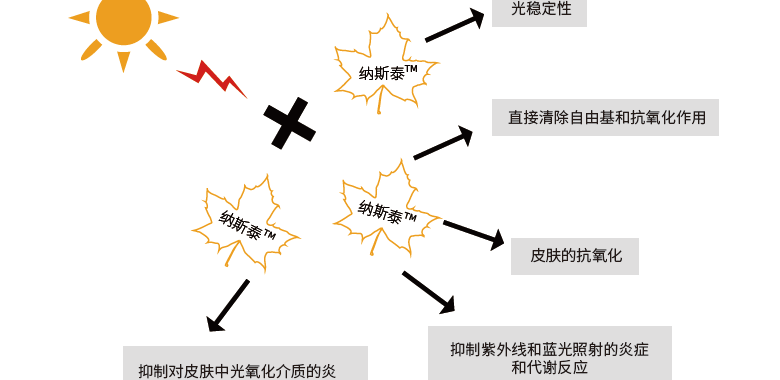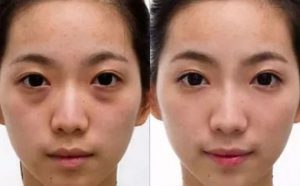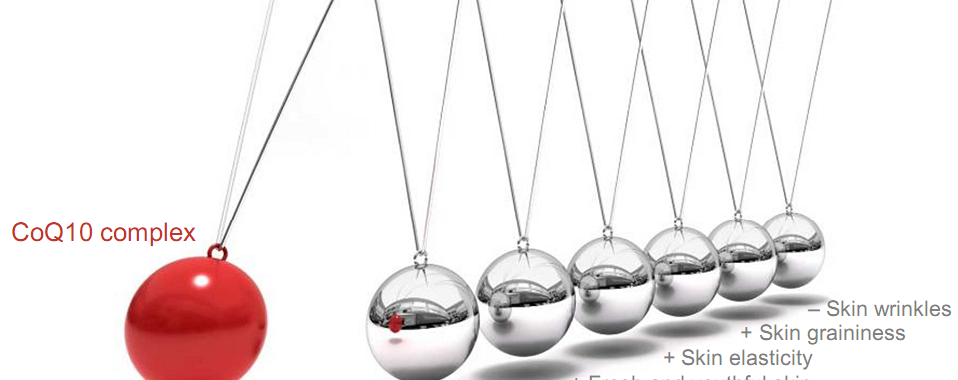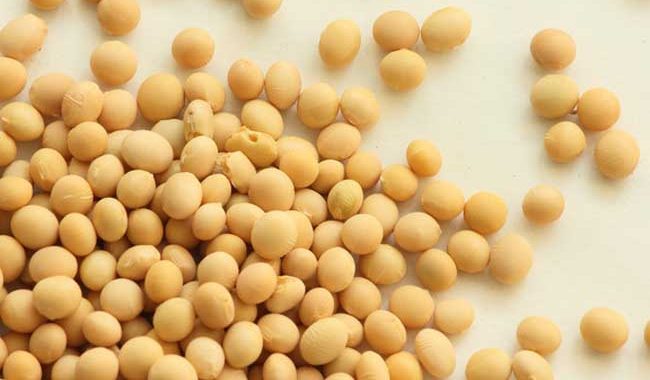NanoActive RAL
Nanoactive RAL, INCI name: Retinal, CAS: 116-31-4.
Product Name: Nanoactive RAL, BioaActive Retinaldehyde; BioActive Retinal; Soluble Retinal; Soluble Retinaldehyde;Nano Liposomal
Nanoactive RAL is a novel retinal nanoliposome formulation (NanoLiposomal RAL).
A new liposome preparation. RAL has the characteristics of retinoic acid in the skin, and is better tolerated than retinoic acid. It directly interacts with protein receptors in cells, stimulates epidermis to accelerate regeneration, increases the thickness of the stratum corneum, and makes the skin tighter and more orderly. It also accelerates the production of collagen in the dermis layer, prevents the damage of UV to collagen, inhibits the increase of MMP caused by UV, and makes the skin more elastic; the unique aldehyde-based structure has a very good effect on P. acnes, etc., and effectively improves acne skin. Large amounts of retinal, retinol, retinol retinate (15498-86-9), HPR(893412-73-2) and other Vitamin A kind products of pharmaceutical grade are available.
Description:
Retinaldehyde (RAL), also known as vitamin A aldehyde, is a derivative of retinol after oxidation. It is formed by oxidative cleavage of β-carotene. If reduced, retinol can be attained; If oxidized, retinoic acid can be attained.Retinoic acid。”. The role of retinoic acid (Vitamin A) in skin diseaseis very extensive, but due to local irritation, its clinical application is limited to some extent.Retinaldehyde is an intermediate metabolite of natural retinoic acid and has similar biological activity as retinoic acid. But the skin is significantly more tolerant to retinoic acid.
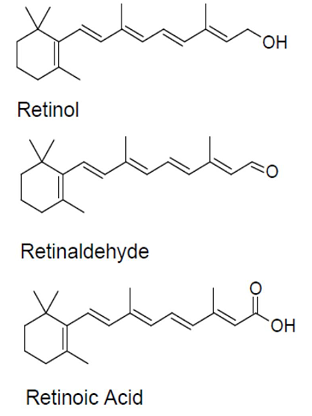
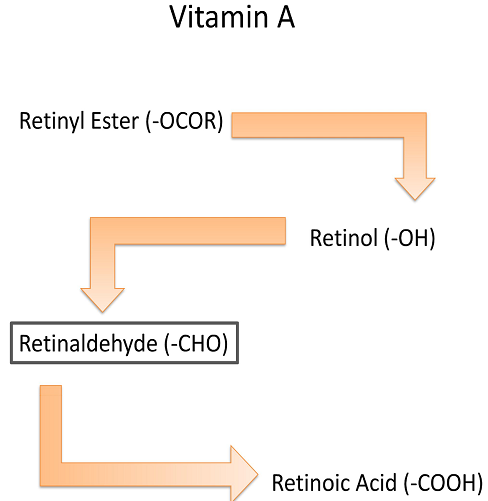
The main forms of vitamin A and their interconversion
Retinal has many target on the skin. It can be used as a skin care product to produce a variety of effects such as anti-aging, skin rejuvenation, whitening, anti-wrinkle, acne, keratin, etc. It is an emerging high-efficiency natural active substance. Retinal is hardly soluble in water while easy to be oxidized and discolored, which limits its application in cosmetics. Nano actives with a particle size of less than 30 nm developed by nano-transmission system (NDS) enable retinals to be steadily wrapped in nano-carriers, greatly improving the absorption efficiency and bioavailability. This overcomes the original defects and maintain the advantages and enables a more convenient and wider range of uses.
Skin care effect
The large use of non-physiological doses of exogenous retinoic acid can cause an overload of the retinoic acid-dependent pathway in the skin, causing adverse reactions such as skin irritation. RAL is a natural metabolite of retinol and a direct precursor of retinoic acid, and it also has similar biological activity to retinoic acid. The advantage of RAL compared with retinoic acid is its multi-directional metabolism, that is, the excess RAL can be rapidly reduced to retinol, then stored and inactivated in the form of retinol, and this “reverse metabolism” is not present in retinoic acid. After it is absorbed by the skin, most of it is converted to retinol vinegar stored for slow release, and a small amount of RAL is oxidized to retinoic acid by keratinocytes in differentiation-dependent manner, while a very small amount of retinoic acid is can exert significant biological effects in cells. This can avoid skin adverse reactions caused by high doses of retinoic acid. Clinical observations also show that topical RAL creams are well tolerated compared with retinoic acid and can be applied to sensitive areas. The topical RAL cannot absorbed by human blood. The levels of various vitamin A acids in the blood also cannot be affected.
RAL needs to be activated by the conversion of enzymes in keratinocytes to retinoic acid, so RAL has similar biological activity as retinoic acid. One of the indicators of retinoic acid activity is to induce the expression of retinoic acid binding protein (CRABP-2) in cells. External RAL can evidently induce the expression of CRABP-2 mRNA and protein. The topical natural retinoic acidcan also induce the expression of nuclear receptor in retinoic acid . Like retinoic acid, RAL also functions to regulate cell proliferation and differentiation. It can increase epidermal DNA synthesis, increase epidermis thickness, induce 50kD keratin, and reduce 7OkD keratin mRNA expression. Inducing positive keratinization, reducing 65kD keratin mRNA expression, and increasing filaggrin and loricin mRNA expression. In addition, RAL is also involved in the regulation of neovascularization in the skin, inhibiting the production of vascular endothelial growth factor by keratinocytes. It can repair the elastic fibers and collagen damage induced by UVA. RAL is also capable of dissolving acne and the direct sterilizing effect towards propionibacterium acnes. Natural retinoic acid play an important role in epidermal differentiation, dermal remodeling and curing skin inflammation. Retinaldehyde as an important intermediate metabolite of natural retinoic acid has both biological activity similar to that of retinoic acid and is well tolerated by the skin, thus it is given wider application in cosmetics.
Retinaldehyde can repair elastic fiber and collagen loss caused by UV:
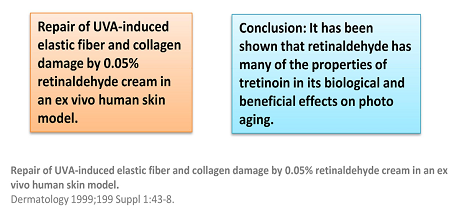
Retinaldehyde prevents skin aging caused by ultrasound and fluid
technology:
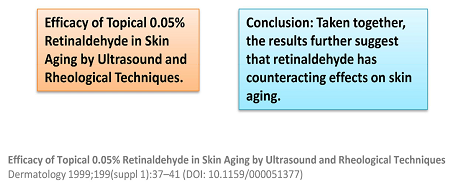
Retinaldehyde can effectively improve skin photoaging symptoms:
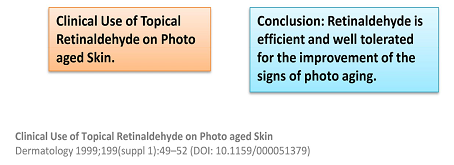
Retinaldehyde and retinal are well tolerated, while retinoic acid is more irritating
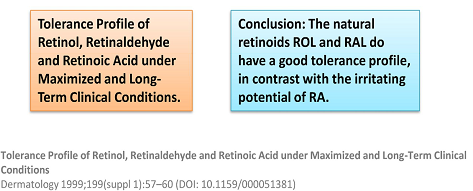
Retinaldehyde can effectively inhibit epidermal melanin
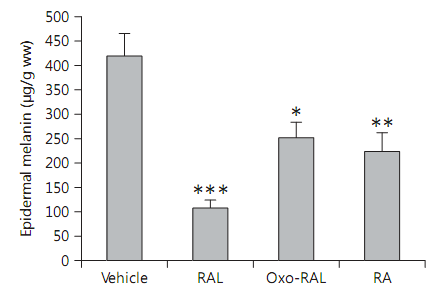
Features
- NanoActive Retinaldehyde uses FDA GRAS grade materials for high safety
- NanoActive Retinaldehyde has good heat, pH and sheer stability and is easy to use.
- NanoActive Retinaldehydegreatly enhances the stability and bioavailability of retinal
- NanoActive Retinaldehyde can improve the stability of other active matters in the product and facilitate absorption
- NanoActive Retinaldehyde is 100% water soluble and 100% oil soluble, allowing a wide range of uses.
Applications
- Wrinkle repairing: promote collagen and hyaluronic acid synthesis, increase skin thickness and elasticity, repair the wrinkle and firm the skin.
- Whitening and freckle removing: inhibit melanin synthesis, reduce pigmentation, whiten the skin and remove the freckle.
- Anti-aging: anti-oxidation, anti-skin-aging
- Skin-refreshing: renewal of keratin, refresh the skin.
- Acne Treatment: sterilizing propionibacterium acnes and streptococcus, etc., treating acne and removing acne marks
- Curing of skin photoaging
Use: Add it at room temperature; recommended dosage: 1-5% The optimum pH range of the system is 3.0-6.5, and the finished product should avoid direct exposure to sunlight (using opaque packaging). It is recommended to add UV absorber to day care products.
Storage: keep it away from light at a temperature below 25℃.
NanoActive Sulfur
Nanoactive Sulphur is a new type of sulphur nanoliposome preparation (NanoLiposomal Sulphur).
Product Name: Nano Liposomal Sulfur; Nanoactive Sulfur; BioaActive Sulfur; Soluble Sulfur CAS: 7704-34-9
Description :
Sulfur has long been an effective drug for the treatment of various skin diseases. It is a yellow non-metallic element widely distributed in the earth’s crust. The function of sulphur depends on its direct interaction with the skin. The smaller the particles are, the larger the effective area of interaction between sulfur and the skin is, and the greater the efficacy is. Nanobiosulfuris a sebum regulating agent that has triple effects on problem skin, namely antibacterial, anti-inflammatory and sebum regulating. Water-soluble and non-irritating to the skin, in cosmetics, it can regulate the secretion function of sebaceous glands, facilitate skin whitening. It is also effective in anti-bacteria, reducing the appearance of whelk, acne and dandruff. SulfurSarcoptic Mitecan kill bacteria and fungus, strip the skin of oil, soften the epidermis, dissolve the keratin Sulfurby forming pentathionic acidSecretionafter interactingHydrogen sulfidewith skin and tissue.
Lipoic acid nanoactive material with a particle size of less than 30 nm developed by Nano-transport system (NDS) has completely solved sulfur’s solubility problem, allowing it to be stably encapsulated in a nanocarrier, which can greatly increase its absorption efficiency and bioavailability.
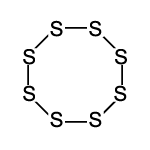
Lipoic acid’s structure
Sulphur is a yellow colored non-metal element, widely distributed throughout the planet. Different sulphur-based topical preparations have been developed through the years.
Sublimed sulphur is prepared by changing sulphur from solid to gas (sublimation). The resulting gas is subsequently condensed into fine yellow powder, which can be used in different ways. The physical properties of sublimed sulphur differ from those of precipitated sulphur. Sublimed sulphur, Washed sulphur, is made of large particles with mild therapeutic efficacy; it is yellow, nonsoluble in water or alcohol, slightly soluble in olive oil (10%) and tastes slightly acidic. Washed sulphur is sublimed sulphur, treated With diluted ammoniac first and boiling water afterwards. Precipitated sulphur, also called magistery of sulphur or milk of sulphur, is made of small particles with high therapeutic efficacy; it is whitish-yellow, non soluble in water, slightly soluble in alcohol, soluble in 1:100 olive oil and insipid.
Nanoactive sulphur consists of minute particles, smaller than those of precipitated sulphur (1 to 100 nm), which can be suspended in a colloidal solution. So far, this form is considered the most active one. Currently, the so-called biosulphur is most Frequent used, because of its better diffusion and higher activity on the skin.
TRADITIONAL USES
Sulphur has been used for medicinal purposes since the times of Hippocrates. Commercially, this product is important to produce sulphuric acid, abundantly used in the chemical industry and others.
COSMETIC PROPERTIES
Keratolytic properties
The action of sulphur depends on its direct interaction with the skin. The smallest particle sizes have the largest interaction area and therefore, they are most efficient. For many years, sulphur has been considered a specific remedy for seborrhea, used as octahedral sulphur solution in The therapeutic effects of sulphur on acne-prone skin or skin with excessive sebum secretion could result from its keratolytic action. The mechanism underlying such effect is not known; it probably depends on the interaction of sulphur with the cysteine Into keratinocytes

Cystine is a major constituent of the horny layer. This reaction promotes normal keratinization, due to the keratoplastic effect of sulphur, applied at low concentrations.Applied at high concentrations, the same reaction causes keratolytic effects, because sulphur hydrogen breaks keratin.It is possible That applications of high sulphur concentrations on the skin result in sulphur hydrogen enough enough to dissolve the horny layer
Therefore, nanoactive sulphur fluid is recommended to formulate cosmetic products with regulatory activity on sebum secretions.
Antifungal action
Sulphur antifungal action depends on the conversion of sulphur into pentathionic acid, a
Compound toxic to fungi. Sulphur hydrogen formation could also be involved in this action.
Applied on the skin, sulphur turns into pentathionic acid due to the action of skin bacteria and
Keratinolytic. of keratolytic action of sulphur could cause the fungi to detach from the horny layer
Therefore, nanoacive sulphur fluid is recommended to formulate cosmetic products with purifying and antiseptic action
COSMETIC APPLICATIONS
Features
- NanoActive Sulfur uses FDA GRAS grade materials for high safety
- NanoActive Sulfur has good heat, pH and shear stability and is easy to use.
- NanoActive Sulfur greatly improves the stability and bioavailability of ALA
- NanoActive Sulfur improves the stability and absorption of other actives in the product
- NanoActive Sulfur is 100% water soluble and 100% oil soluble (amphiphilic) for a wide range of applications
Product use:Add at room temperature,heat it to above 40°C to speed up its dissolution. Recommended dosage: 1-3%. Better effect with products containing lipoic acid.
Product storage: Keep below 25°C and away from light.
NanoActive Repair
Nanoactive Repair is a novel ceramide nanoliposome preparation (NanoLiposomal Repair).
Product Name: Nano Liposomal Ceramide; Nanoactive Ceramide; BioaActive Ceramide; Soluble Ceramide; Nanoactive Repair; Bioa Active Repair; SymRepair 100 CAS: 100403-19-8
Description: The results of skin research indicate thatceramide is the main component of the skin’s stratum corneum lipids, accounting for about 50% of the epidermal keratinous lipid content. It plays a key role in the physiological function of the stratum corneum and takes on the role of skin protection, moisturizing and nourishing. The application of a skincare product containing ceramide for external use can achieve the purpose of preventing allergic skin diseases and the effect of suppressing melanin brown spots. The ceramide-3 with the same structure as natural ceramide is used as the raw material. The nano-ceramides, developed with the nano-transmission system (NDS), has a particle size of less than 30nm, which solves the problems of solubility and irritation, so that it is stably encapsulated in nano-carriers to synergize with natural stratum corneum components of skin, such as phospholipids, cholesterol and stearic acid to repair the barrier.

Ceramide-3 structure
The main role of ceramide in the stratum corneum of the epidermis:
- Barrier: As long as the ceramide is removed from the epidermis, the barrier function of the skin disappears.
- Adhesion: Ceramide can significantly enhance the adhesion between keratinocytes, improve skin dryness and reduce skin desquamation.
- Moisturizing: Ceramide has a strong ability to associate water molecules, maintaining the moisture of the skin by forming a network in the stratum corneum.
- Anti-aging: Ceramide can improve skin dryness, desquamation, roughness and tarnishing, increase skin thickness, improve skin moisturizing ability, reduce wrinkles, increase skin elasticity and delay skin aging.
- Anti-allergy: Ceramide can help the stratum corneum thicken significantly, improve the skin’s tolerance, inhibit the invasion of harmful substances from the outside, avoid the sensitivity of skin caused by the invasion, and have the effect of restoring couperose skin.
However, many skin conditions can cause a decrease in ceramide levels leading to impaired skin barrier (more than 50% reduction in total ceramide or single ceramide):
- Aging
- Allergic dermatitis
- Dry skin / dry skin in winter
- Dandruff
- Psychological stress
- Gender (older women versus older men)
- Race/skin type
Ceramide is the most important component of the lipid barrier of the skin, and ceramide can repair the skin barrier function. However, it is difficult to extract natural ceramides, to synthesize natural ceramides, to formulate natural or natural ceramides with high melting point (over 90 C), and to crystallize low concentration, ineffective and high concentration products, which limit the use of ceramides. A new type of synthetic ceramide developed similar to the natural ceramide structure is used as the raw material, and the nano-ceramides with a particle size of less than 30 nm developed by the nano-transport system (NDS) have solved the problem of solubility and applicability. It is stably encapsulated in a nanocarrier to synergize with skin natural stratum corneum components such as phospholipids, cholesterol and stearic acid to repair the barrier.
Research shows this product has:
- A dose-dependent feature in repairing skin lesions
- A comparable efficacy to natural ceramide
- An effect of preventing skin lesions
- A restoring effect
- A good moisturizing effect

Ceramide for allergic skin repair
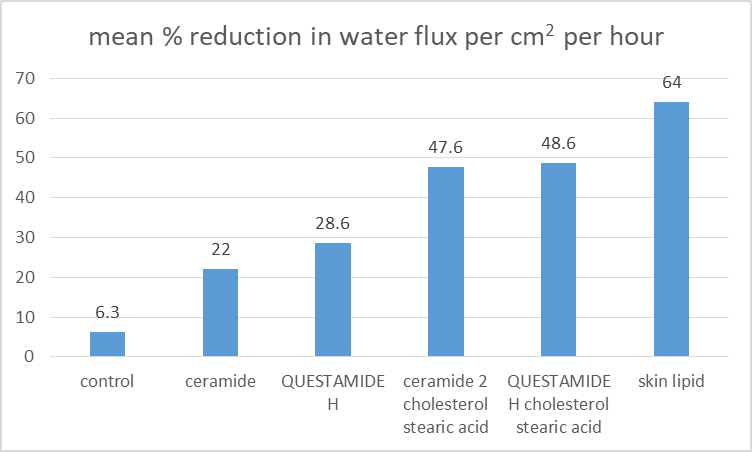
Ceramide can effectively reduce the water flux of defatted pigskin (in vitro)
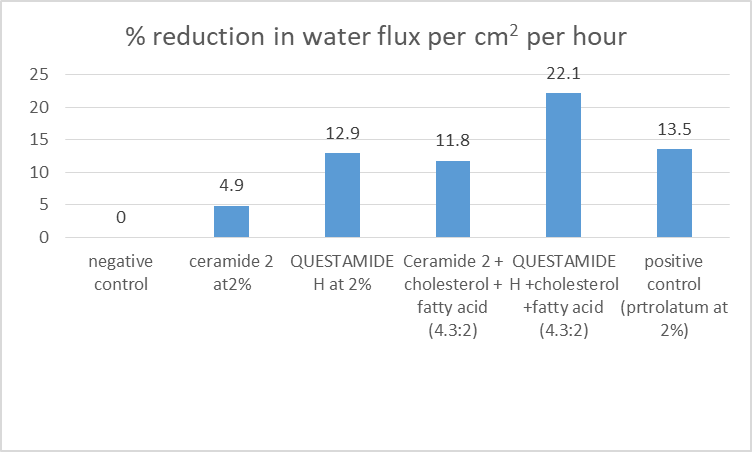
Ceramide effectively reduces the transepidermal water loss rate of human bodies (TEWL)
Applications:
- Skincare
- Bodycare
- Facial care
- Dry skin care
- Winter skincare
- Daily skincare
- Anti-aging products
- Products for sensitive skin
- Sunscreen products
- After-sun repair products
Use:Add it at an ordinary temperature; recommended dosage: 5-10%. Better effect with products such as yeast glucan liposome.
Storage: Keep it away from light at a temperature below 25℃.
Nano-Lipoic Acid (NanoActive ALA)
Nanoactive ALA is a new type of lipoic acid nanoliposome preparation (NanoLiposomal ALA).
Product Name: Nano Liposomal ALA; Nanoactive ALA; BioaActive ALA; BioActive Alpha lipoic acid; NanoActive Alpha lipoic acid; Soluble alpha lipoic acid; Soluble ALA CAS: 62-46-4
Description: Alpha lipoic acid is an enzyme existing in mitochondria, which is similar to vitamins and can eliminate free radicals that accelerate aging and cause disease. Lipoic acid has both fat-soluble and water-soluble properties, so it can pass through the entire body and reach every cell, providing comprehensive performance for human body. It is an all-purpose antioxidant with fat solubility and water solubility. Lipoic acid has the antioxidant effects 400 times greater than that of vitamins C and E, and it can greatly enhance the effects of vitamins C and E. Also, its efficacy lasts longer than other antioxidants. Smaller than the molecules of vitamin E, it can be easily absorbed by the skin and be effective in beautifying, activating cells and facilitating hair growth. Lipoic acid is effective in removing dark eye circles, wrinkles and spots. In addition, it enhances metabolism, improving the body’s blood circulation, so that skill will no longer be dull and the appearance or pores will be minimized, making your skin enviously firm and delicate. Therefore, lipoic acid is also an anti-aging nutrient that ranks the first place in the United States, which ties with ALA. The lipoic acid nanoactive material with particle size less than 30nm developed by nano-transmission system (NDS) completely solves the problem of solubility, and allows lipoic acid to be stably encapsulated in nano-carriers, which can greatly increase its absorption efficiency and bioavailability.

Lipoic acid’s structure
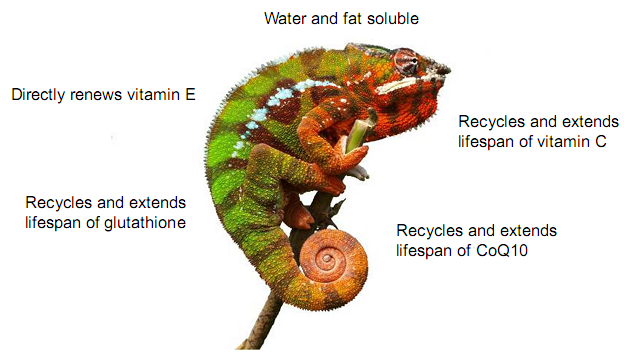
Lipoic acid is an powerful versatile anti-oxidant that can regenerates other antioxidants.
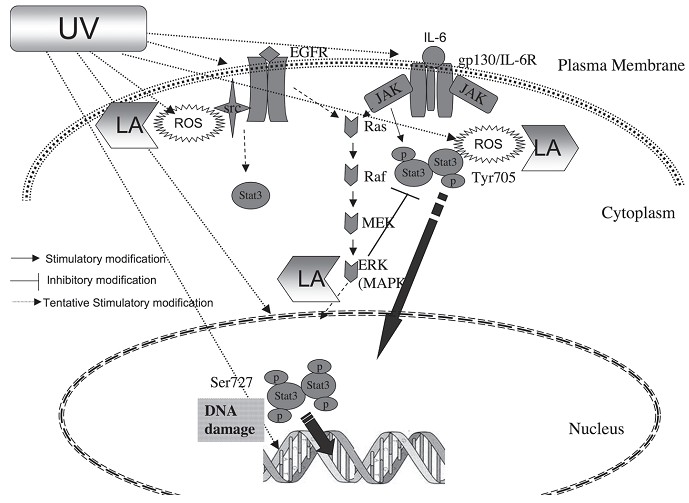
Lipoic acid (LA) target against skin aging
Features
- NanoActive ALA uses FDA GRAS grade materials for high safety.
- NanoActive ALA has good heat, pH and shear stability and is easy to use
- NanoActive ALA greatly improves ALA’s stability and bioavailability
- NanoActive ALA improves the stability and absorption of other actives in the product.
- NanoActive ALA is 100% water soluble and 100% oil soluble (amphiphilic) for a wide range of applications.
Efficacy
- NanoActive ALA can enhance the anti-oxidation effect of skin cells, reduce the damage from free radicals to the skin, significantly reduce skin roughness, eliminate freckles and reduce the appearance of fine lines.
- NanoActive ALA is an active functional ingredient that is effective in anti-wrinkles, whitening, anti-aging, moisturizing and increasing skin elasticity.
- It helps to enhance the efficacy of antioxidants such as polyphenols and kinetin, and also reduces the endogenous antioxidants.
Use: Add it at room temperature. You may heat it to above 40 °C to speed up its dissolution, Recommended dosage: 1-3%. Better effect with products containing lipoic acid.
Storage: Keep it away from light at a temperature below 25°C.
Experimental proof
Effect of lipoic acid on cell activity
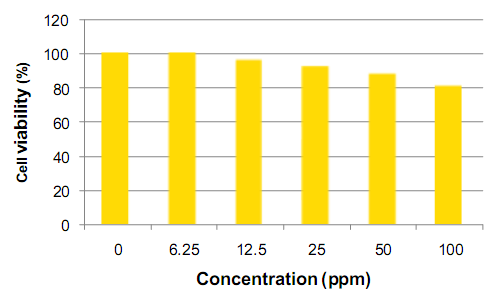
Lipoic acid’s whitening effect
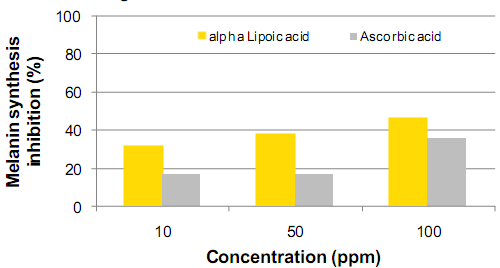
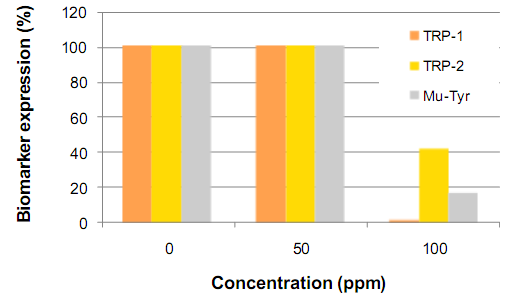
Lipoic acid’s anti-wrinkle effect
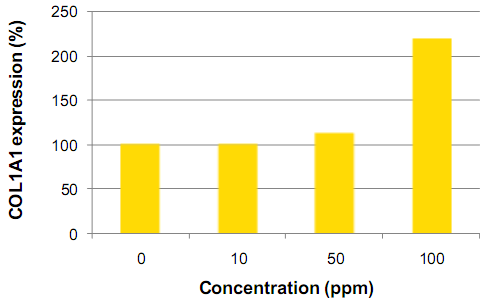

NanoActive Curcumin
Nanoactive Curcumin is a new type of curcumin nanoliposome (NanoLiposomal Curcumin).
Product Name: Nano Liposomal THC; Nanoactive THC; BioaActive THC; BioActive curcuminoids; NanoActive curcuminoids; Water Soluble curcuminoids; Fat Soluble curcuminoids CAS: 36062-04-1
Description: Curcumin is a yellow pigment extracted from the rhizome of Curcuma longa of the ginger family. It is an acidic polyphenolic substance with an unsaturated aliphatic and aromatic group in the main chain. According to records, the people of the Indian subcontinent have a turmeric-eating history of 5,000 years. Curcumin is now a natural product of great importance to global scientific community. In the past two decades, about 4,500 papers on curcumin have been published in various scientific journals around the world. Studies have shown that curcumin has a variety of biological activities, such as anti-oxidation, anti-infection, anti-inflammatory, anti-coagulation, anti-atherosclerosis and inhibition of tumor growth. The application of curcumin in skincare products has been widely recognised at home and abroad, and has been increasingly applied to whitening, anti-allergy,anti-inflammatory and other products. However, curcumin is difficult to dissolve in water, and easily oxidized,which limit its application in cosmetics. Nano-active materials with a particle size of less than 30 nm developed by nano-transmission system (NDS) are used to stably encapsulate curcumin in nano-carriers so that the absorption efficiency and bio-availability can be greatly increased. This has largely overcome its defects while retained its advantages, making it application is more easily and widely applicable.
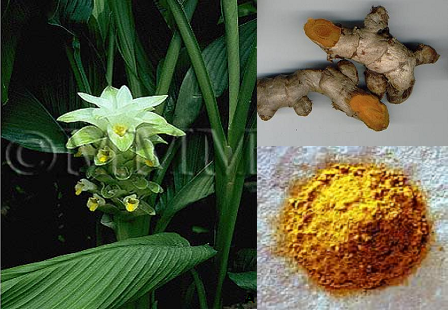
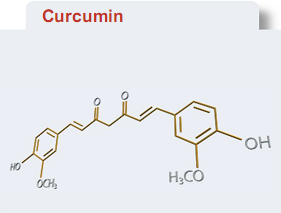
Turmeric and curcumin

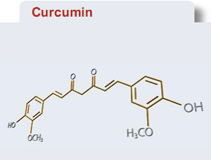
Curcumin has served as a traditional medicine in Asian countries for thousands of years.
The number of research papers on curcumin in recent years
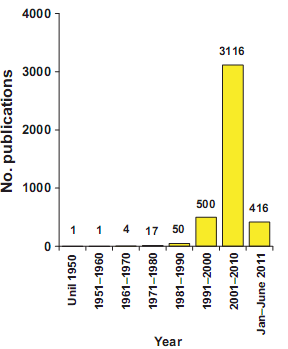
Papers on curcumin nano preparation in recent years
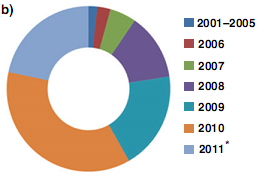


odern biomedical research shows that curcumin has a high therapeutic effect on many diseases
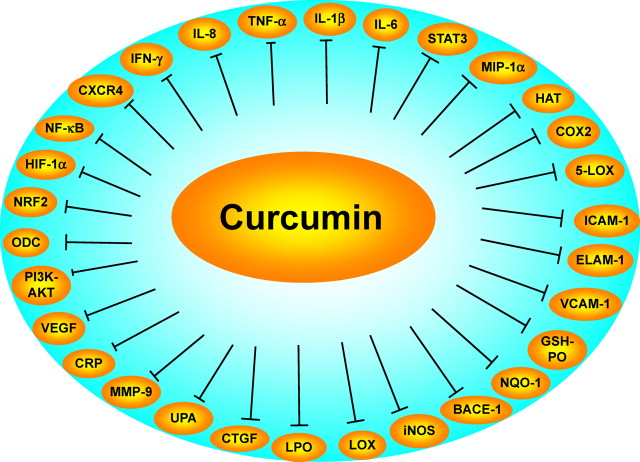
Curcumin inhibits inflammatory reaction through multiple pathways
Nano-curcumin is a model for the combination of traditional medicine, modern medicine and nanotechnology
Curcumin in skincare products:
- Inhibits the expression of matrix metalloproteinase 2, prevents the formation of wrinkles and melanin, increases skin thickness and elasticity by increasing the diameter and length of skin vessel
- Absorbs UV rays, inhibits melanin synthesis, reduces pigmentation, and whitens the skin
- Eliminate free radicals and confront skin aging
- Help heal wounds and reduce scars
- Cure acne and reduce acne marks
- Anti-bacteria, diminish inflammation and sensitization, and provide analgesic effects
- Prevent scarring and fibrosis
- Prevention and treatment of skin cancer
- Treatment of psoriasis
Features :
- NanoActive Nano-curcumin uses FDA GRAS grade materials for higher safety.
- NanoActive Nano-curcumin is stable to heat, pH and cuts, so it is convenient to use..
- NanoActive Nano-curcumin greatly improves the stability and bio-availability of nano-curcumin
- NanoActive Nano-curcumin improves the stability and absorption of other actives in the product.
- NanoActive Nano-curcumin is 100% water soluble and 100% oil soluble (amphiphilic)
Use:Add it at room temperature. You may heat to above 40 °C to speed up dissolution rate. Recommended dosage: 1-5%.
Storage: Keep it away from light at a temperature below 25°C.
NanoStemCellTM
NanoStemCell anti-aging repair solution (NanoStemCellTM) is a novel skincare material developed by PuriPharm’s chief scientist Professor Robert J Lee and his team using plant extract, modern biomedicine and nano-transmission technology. It resists UV rays and blue laser radiation, and is featured with the functions of anti-oxidation, promoting extracellular stroma synthesis and repairing the stem cells of skin, thus acting as an anti-pollution and anti-aging repair from within. It is a new type of 4D anti-aging and wrinkle removing solution, applicable to deep anti-wrinkle, preventing dark eye circles, controlling oil, eliminating acnes, anti-aging and protection from blue lasers.
Salvia miltiorrhiza and Buddleja officinalis, the traditional Chinese medicinal materials, contain a large number of functional compounds with good biological activity and significant pharmacological features. The PuriPharm team uses modern biotechnology to screen and extract the essence of their efficacy. The nano-transmission technology can 100% penetrate epidermis, directly reach basal cells and target the stem cells in the deep layer of your skin.


Salvia miltiorrhiza Buddleja officinalis

Schematic diagram of epidermal stem cell differentiation
The skin is a layered tissue, from bottom to top, composed of subcutaneous tissues, dermis, and epidermis that contains original skin flora. The skin is the most vulnerable to external invasion, but it can constantly renew itself thanks to the stem cells in the basal layer of epidermis. These stem cells undergo a specific division process, produce new cells and further differentiate into keratogenesis cells. Under normal conditions, keratogenesis cells will automatically convert into keratinocytes and secrete intercellular gums composed of cholesterol, fatty acids and ceramides, which help to form a skin barrier function to prevent dehydration.
Skin balance is constantly challenged by internal aging processes, UV rays, contaminants, screen light of electronic products and external stimuli, resulting in dramatic changes in the epidermal structure. Over time, due to the decreased activity of epidermal stem cells and efficiency of cell differentiation, epidermal cell renewal will slow down, and eventually, the following situations will happen to the skin:
- The barrier function is weakened and the hydration is decreased (the barrier function of keratinocyte skin is reduced);
Fine lines and wrinkles appear (the number of cells and the cohesion of the
- skin are reduced);
- Exfoliated epidermis accumulates (reduced exfoliation process);
- Microbial flora loses balance (unbalanced or fragile stratum corneum microecology).
Over time, the entire renewal process of the skin epidermis slows down due to the lower activity of epidermal stem cells and the less efficient cell differentiation process. The skin becomes dry, rough and vulnerable, and fine lines as well as wrinkles appear. Maintaining the activity of epidermal stem cells is a key factor in ensuring skin vitality and regenerative capacity. NanoStemCellTMis a new generation of UV protective active ingredient developed by PuriPharm, the main raw materials of which are Salvia miltiorrhiza and Buddleja officinalis extracts. NanoStemCellTMprovides five protections when protecting epidermal stem cells from aging caused by UV radiation:
1) Absorption of UV rays, high-energy visible light, and blue lasers: Compared with chemical absorbents, NanoStemCellTMcan better absorb UV and blue lasers.
2) Effective reduction in the screen light damage of electronic products: Under normal circumstances, the screen light of electronic products decreases the mitochondrial ATP synthesis rate, the type I procollagen content, and the cell proliferation activity, and lead to the change of fibroblast morphology. NamoStemCellTM effectively reduces the extent to which screen light destroys mitochondrial function and damage to fibroblast morphological structure, and reduces the adverse effects of visible light emitted by electronic screens on the skin.
3) Restriction on the conversion of trans-UCA (urinary acid) to cis-UCA caused by UV exposure: urinary acid exists in the stratum corneum, and when exposed to UV irradiation, trans-uric acid is converted into cis-uric acid. This is the innovation of the new active ingredient of NamoStemCellTM: the active ingredient prevents the conversion of trans-urinary acid to cis-uric acid, thus limiting the adverse effect of apoptosis, immunosuppression and ROS (reactive oxygen species) formation.
4) Reduction in lipid peroxidation: Lipid peroxidation is the process during which free radicals “steal” electrons from lipids in the cell membrane, ultimately leading to cell damage. In vitro, an additional 0.3% Nasta TMcan reduce the UV light-induced lipid peroxidation by 54%.
5) Protection for the epidermal stem cells that maintain and restore the epidermis: in the epidermis, epidermal stem cells exist and have quite unique functions: renewing the epidermis and repairing damaged tissues by continuously forming new keratinocytes,. As the skin ages, this process will slow down while the number and activity of stem cells will decrease. Unhealthy lifestyles, UV and blue laser exposure will make this pay and cause the skin to be thiner, slacker, more wrinkled and less moisturized. Therefore, it is very important to protect these stem cells while maintaining and repairing the epidermis. NanoStemCellTMprotects and maintains the activity of epidermal stem cells and limits oxidative stress caused by exposures to UV rays and blue lasers. The new active element mainly composed of Salvia miltiorrhiza and Buddleja officinalis can prevent aging and photo-aging effects through the four mechanisms above, and protect the dermal components from the oxidative stress induced by UV rays and blue lasers.

NanoStemCellTMplays a role in the activity of photo-protective agents for skin cells
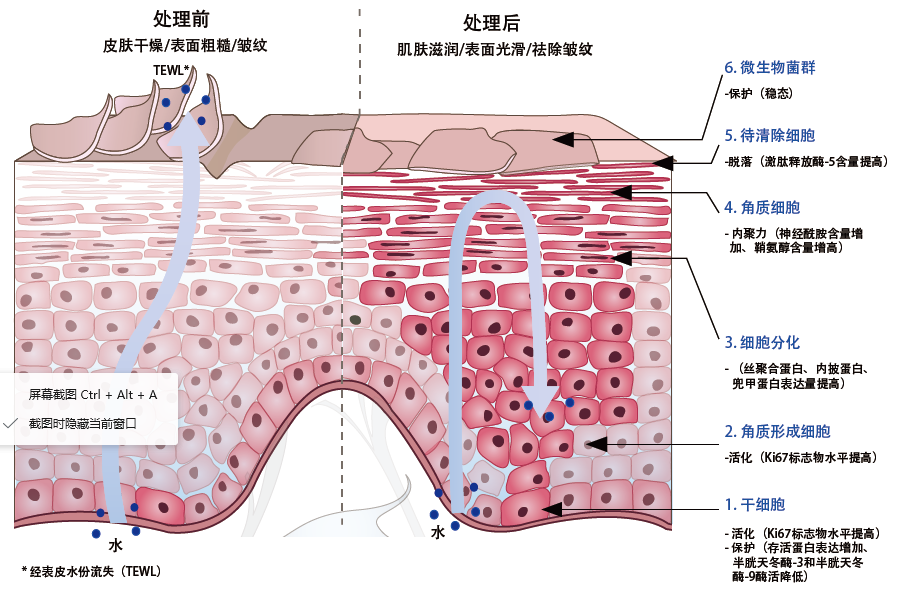
Skin conditions before and after the use of NanoStemCellTMactives
In vitro, in vivo and clinical studies have shown that NanoStemCellTMhas a natural and unique skin reactivation effect. The skin activation takes effect from within through the following six synergies:
- Protect and activate skin stem cells
- Reactivate cell metabolism
- Stimulate cell differentiation
- Enhance skin barrier structure
- Reactivate natural exfoliation
- Actively protect skin microbial flora
This versatile active ingredient will benefit users in just 2 weeks. Compared with the control one, the product has better skin moisturization and skin surface improvement with a wrinkle reduction of up to 30%.
Biological activity: activation and protection of stem cells in vitro
- Cloning Ability of Stem Cells
We cultivated human stem cells (external root sheath) for 48 hours with and without 0.5% actives, respectively, and evaluated their cloning ability with optical microscopy.
Untreated stem cells Stem cells + 0.5%NanoStemCellTM

Isolated stem cell Clones of stem cells
RESULTS: Compared with the unprocessed cells, we found that the addition of actives had a significant effect on the cloning ability of stem cells, indicating that NanoStemCellTMcan maintain the cloning ability of skin stem cells.
2.Protect stem cells from UV rays
|
We processed samples of human stem cells (external root sheath) with and without actives, exposed them to two doses of UVA (8J/cm2) and UVB (150mJ/cm2) respectively, and observed the expression of activating protein that survives through immunofluorescence.
Untreated stem cell Stem cells + UV rays

RESULTS: NanoStemCellTMincreased the expression of activating protein that survives after UV irradiation by 171% compared with normal values, thereby protecting stem cells from apoptosis under this condition.
3.Directly inhibit pro-apoptotic enzymes
We added 0.1%, 0.5%, and 1%, three gradient concentrations of actives, and measured the activity of apoptosis proteases, caspase-9 and caspase-3 through spectrophotometry.
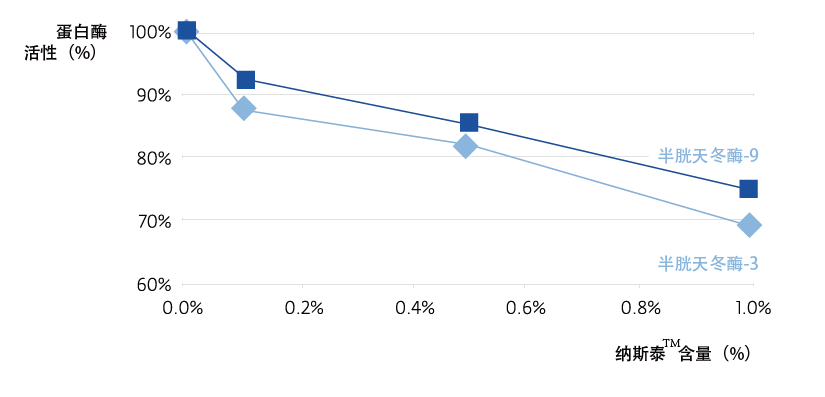
RESULTS: The inhibition rate of NanoStemCellTMto both enzymes is 31%, indicating that the actives have anti-apoptotic effects.
Stimulate epidermal metabolism (in vitro)
We conducted skin explants on 8 healthy individuals (31 to 67 years old) with three processing methods — no treatment, comparison or 0.5 NanoStemCell™, and measured the expression of Ki67 tumor markers 2 days later through immunohistochemistry .
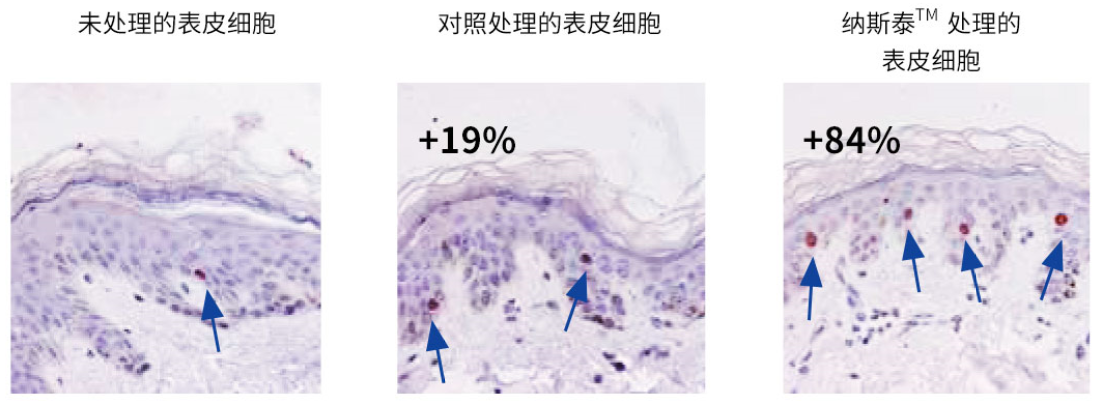
RESULTS: Epidermal metabolism increased by up to +84% after NanoStemCellTMtreatment, compared with the untreated one. In addition, stem cell metabolism at the dermal-epidermal junction (DEJ) was also observed to be activated.
Stimulate keratinocyte differentiation and barrier function (in vitro)
We processed normal human keratinocytes with 0.1% NanoStemCellTMand quantified the expression of mRNA 24 hours later through q-RT-PCR.
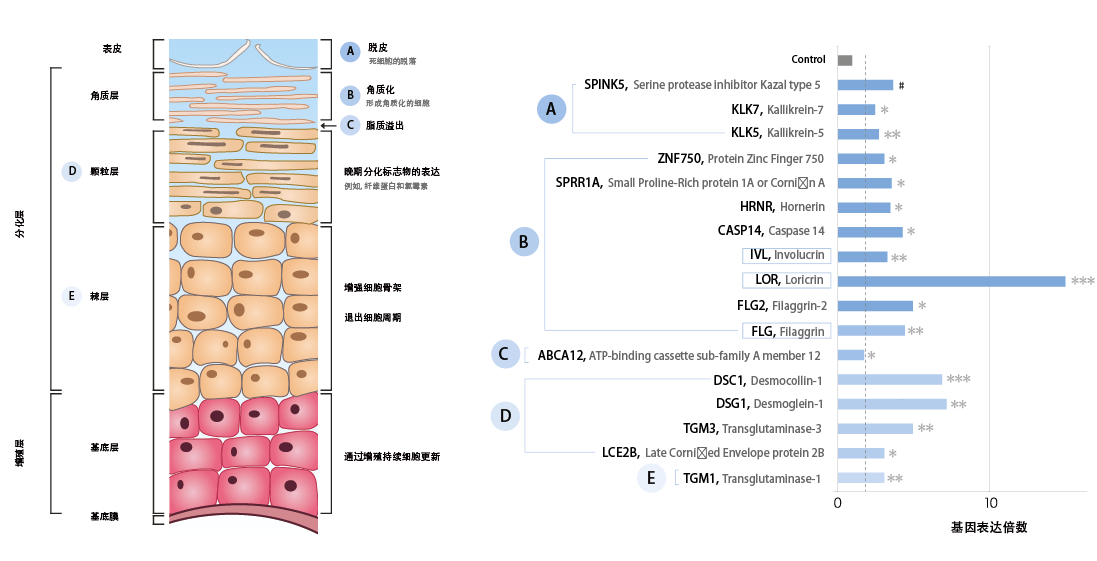
# T test, p = 0.06; * T test, P < 0.05;
** T test, P < 0.01; *** T test, P < 0.001
RESULTS: NanoStemCellTMsignificantly increased the expression of all genes involved in keratinocyte differentiation, including those related to maintaining barrier function.
Improvement of epidermal differentiation and barrier function (in vitro)
We exfoliated reconstructed human epidermis (RHE) after 11 days to simulate the barrier defects of skin. Two days later, we adopted immunostaining to observe three proteins affected by NanoStemCellTM: involucrin, filaggrin, and loricin.

* T test, P < 0.05;** T test, P < 0.01; *** T test, P < 0.001
RESULTS: Compared with the control one, NanoStemCellTMresulted in significant overexpression of three protein markers (statistically), with a filaggrin expression of up to 250%, an involucrin expression of up to 490%, and a loricrin expression of up to 470%. It is obvious that NanoStemCellTMplays an extremely important role in the maintaining the epidermal differentiation and barrier function.
Stimulate the production of skin barrier tissue (in vitro)
The reconstructed human epidermis (RHE) was prepared from keratinocytes of a 24-year-old female donor and exposed to air for 10 days. The RHE was treated with a mixture of cytokines from D6 to D10 period to simulate barrier defects caused by local inflammatory stress. It is processed with and without 0.5% NanoStemCell™, and we analyzed the total content of ceramide by LC/MS. Such experiment was repeated for 3 times.


* T test, P<0.05 **T test, P<0.05
RESULTS: NanoStemCellTMstimulated an increase in the total amount of epidermal ceramide, and the ceramide content increased by 37% compared with the control one, demonstrating the ability of the skin barrier function to recover. Meanwhile, it also increased the average chain length of fatty acids attached to the main part of ceramide, raising the efficiency of barrier function . As a major ceramide, cytokines had a significant effect on the chain length ratio (C24/C18) of α-hydroxysphingosine. Adding NanoStemCellTMbrought the ratio back to the basic level, or even higher.
Natural bio-reactivation to exfoliate (in vitro)
On the first and the second day, we processed the skin explants from 8 healthy individuals (31 to 67 years old) in three ways — unprocessed, blank comparison and 0.5% NanoStemCell™.
- Expression of KLK5 protease
2 days later, we measured the expression of KLK5 protease through immunohistochemistry. KLK5, i.e., kallikrein-5, was involved in the exfoliation process.

RESULTS: NanoStemCellTMsignificantly activated the expression of KLK5 compared to the unprocessed skin, resulting in an increase in KLK5 positive cells by up to + 13%. Compared to the control one, NanoStemCellTMtreatment showed the inhibition to KLK5 expression.
- Exfoliation
Two days after the treatment, the experts used histological analysis to evaluate the natural exfoliation of the three explants of each donor.

RESULTS: The epidermal exfoliation after NanoStemCellTMtreatment visibly increased by 60% (vs. untreated skin).
Efficacy assessment
Barrier function and hydration improvement (Clinical Study 1 and Clinical Study 2)
To evaluate the benefits of NanoStemCellTMin body care applications, we conducted the first clinical study on 19 women with average dry skin age of 39.5 years old (skin moisture value below 40 AU) through double-blind comparison. 0.5% NanoStemCellTMwere applied to their forearms twice a day; or we did a control experiment (the same formulation without actives).
- Skin barrier strengthening and hydration effect (Raman spectroscopy)
After 14 days and 28 days, we measured the contents of lipid, protein and moisture of the two groups of forearm skins by Raman spectroscopy.

RESULTS: NanoStemCell™ resulted in a significant increase in lipid, protein and water content of the barrier functional tissue in only 2 weeks compared to the control one. After 14 days and 28 days, they increased separately:
- Lipid content increased by 88%
- Protein content increased by 57%
- Hydration increased by 38%
NanoStemCellTMsignificantly restored the barrier function and provided the skin with better hydration.
2.Skin epidermal reconstruction (OCT)
The quality (density and structure) of the volunteers’ skin tissue was analyzed at the 1st, 14th days, and 28th day. We performed the analysis by optical coherence tomography (OCT), chose to observe the contrast between epidermis and dermis, and discovered younger skin.

RESULTS: NanoStemCellTMled to an increase in the density of the stratum corneum and a better contrast of visible DEJs (dermal epidermal junction) between epidermis and dermis. All these results were related to better and younger skin status.
3.Skin surface renewal: exfoliation
Using a skin diagnostic tool to study exfoliation, we conducted the second clinical double-blind control trial for care applications to measure natural skin exfoliation. The study was conducted on 20 women (average age: 44) with a dry leg skin (measured value below 35 AU), using the product or control one twice a day for 28 days.

RESULTS: NanoStemCellTMcaused an obvious increase in skin exfoliation and surface renewal (upper epidermis) by up to 245% compared to the control group.
Maintain microbial flora (Clinical Trial 3 – Skin Microbiota)

To evaluate the benefits of NanoStemCellTMin body care applications, we selected 19 female volunteers with dry skin for the third clinical study. They were between the ages of 19 and 50, with an average age of 39.5. We applied NanoStemCellTMproducts and the control one on their left and right forearms twice a day. On the 1st and 14th days, we conducted metagenome studies such as collecting, extracting and sequencing the microbial DNA of all volunteers. A total of 24 billion DNA base pairs were analyzed by bioinformatics, and the time-varying compositions of flora under the two conditions (the relative abundance of more than 0.1% and that of more than 1%) were compared.

Results: NanoStemCellTMhad an immediate protective effect on the skin microflora. We did not observe any significant change in the microbia on the 14th day, while in the epidermis applied with the control group, the firmicute was found to be significantly affected. In addition, compared with the control one, NanoStemCellTMactivity could inhibit the evolution of a random pathogen (Finegoldia genus) by up to -58%.
NanoStemCellTMbalances and improves skin composition
Skin Rejuvenation and Anti-Aging (Clinical Trial 4)
The fourth 28-day clinical double-blind control trial was conducted on 15 women who had crow’s feet (aged 35 to 55; the average is 43). The volunteers applied a control product to one side of their faces, and applied 0.5% NanoStemCellTMon the other side. On the 14th and 28th days, the relaxation of their skin was analyzed through a silica gel copy and a skin image analyzer.


RESULTS: The skin applied with NanoStemCellTMshowed a significant anti-aging effect after 14 days, the wrinkles decreased by up to 30%, and the total area of wrinkles decreased by 24%.
Solubility: water soluble
Dosage: 0.1-5%
Processing: It may be added at the end of the formulation process with gentle agitation or added directly to the aqueous phase. The preparation temperature shall be controlled below 80 ° C and the pH is between 4-8.
Efficacy: skin renewal and activation, skin repair, skin regeneration, dry skin treatment, anti-aging, anti-wrinkle, skin moisturizing and hydration, enhanced skin barrier, natural skin exfoliation, and protection for skin microbial flora.
Application: cream for dry skin, anti-aging night cream or day cream for face and body, body lotion for dry and thick skin, protective cream for skin microbia, organism regeneration spray, active moisturizing lotion, skin beauty products, and skin rejuvenating essence.
NanoActive Vitamins (NanoActive Vitas)
Anti-aging, eye bags and dark circles
NanoActive Vitas is a new multivitamin nanoliposome preparation (NanoLiposomal Vitas).
Product Name: Nanoactive Vitamin AEK; BioaActive Vitamin AEK; BioActive AEK; NanoActive AEK; Soluble Vitamin AEK;Nano Liposomal AEK
CAS: 79-81-2, 127-47-9, 10191-41-0
Dark circles and eye bags
The color of “dark circles” mainly comes from the venous blood vessels in the capillary veins of the lower eyelid. Poor partial microcirculation is one of main causes for eye swelling and eye bags, which intensifies dark circles in both optical and physiological aspects. Dark circles and bags under eyes go hand in hand, which largely undermine the appearance of the eyes. The main reasons include: fatigue ﹑fluctuating emotions, aging, weakness and lack of skincare.
Ternary multivitamin
Vitamin A can guarantee the normal state of skin tissue and maintain the normal regeneration of basal cells; Vitamin E is a highly effective antioxidant that protects cell activity; menaquinone can control blood clotting and significantly reduce the congestion of capillaries in the lower part of the eye.
- Advanced Biologically Active Amphiphilic Nano- Delivery (BAAN) Technology compounds vitamins
- The multiplexing of VK and VA can significantly reduce dark circles
- The mixing of VE and VA can increase vitamin storage of the epidermis
- The sustained release of VA is crucial for the keratinization of the epidermis
- The ternary compound effects that can remove wrinkles, dark circles and reddish tone ,whiten the skin, anti-aging and sunscreen.
- The product is safe, non-toxic, non-irritating and biodegradable
- It does not contain any preservative system
Efficacy
- Enhances metabolism and mitosis, helps maintain skin softness and elasticity, and delays skin aging
- Protects cell membranes, improves skin microcirculation, and repairs skin safely and effectively
- Reduces dark circles caused by fatigue and postpartum stretch marks
- Anti-inflammatory, anti-wrinkle, anti-reddish and repairing, all in one
Application range
Eye care products and anti-aging products such as serum, eye mask, facial mask, skin care, etc.
Use
Add at room temperature, heating to above 40°C can speed up the dissolution rate. Recommended dosage: 1-5%. Better effects with NanoActive Q10, NanoActive Asta, etc.
Storage:Recommended to store at 2-8°C
Packing specification:1kg, 5kg, 10kg
Recommended dosage:0.5-5.0%
Experimental proof
The nano-multivitamin has little incompatibility, with a structure that can be easily combined with water molecules, showing unique advantages in the formulation.
- Reduce skin roughness
18 volunteers used a cream containing 1% nano-complex vitamins twice a day
for one month. We compared them with the blank control, and used DO D15 D30 for image comparison analysis to evaluate the effect after use (see the figure below). After 30 days, the nano-multivitamin significantly smoothed and brighten the skin.

D0 D15
- Complexion improvement
Twenty volunteers took clinical trials and were randomized into groups of 10 each. They were between 40 and 60 years old and of both genders. They used a facial cream containing 1% nano-complex vitamin twice a day for one month. Quantitative analyses of glossiness, clarity and complexion showed that the users’ skin appeared fresher, brighter and more vibrant (see table below).
| Effect
Item |
Excellent | Good | Modest | Invalid | |
| Complexion | Significant improvement | 60% | 20% | / | |
| Dull skin remission | 20% | / | |||
| Brightness increase | 40% | 40% | 20% | / | |
| Clearness | 60% | 40% | / | ||
- Lighten dark circles and under-eye bags
Twenty volunteers applied a formula containing 1% nano-complex vitamins and blank products respectively to their eyelids twice a day for a month, and provided feedbacks on the differences observed after use through a self-assessment questionnaire (see table below).
| Effect
Item |
Excellent | Good | Modest |
| Dark circles | Reduced by 75% | Lightened by 13% | Lessened by 12% |
| Bags under eyes | 67% Resistable | Reduced by 33% | |
| Crow’s feet | Reduced by 20% | Lightened by 80% |
Note: 1 Good – significant improvement
NanoActive Q10(NanoActive Q10)
Nanoactive Q10 is a novel white coenzyme Q10 nano-liposome preparation (NanoLiposomal Q10).
Product Name: Nano Liposomal CoQ10; Nanoactive CoQ10; BioaActive CoQ10; BioActive Coenzyme Q10; NanoActive Coenzyme Q10; Water-Soluble Coenzyme Q10; Fat-Soluble Coenzyme Q10 CAS: 303-98-0
Description: Coenzyme Q10 widely exists in mitochondria of the whole body. It has stronger antioxidant function than vitamin C and vitamin E. It can effectively eliminate free radicals and has good anti-aging, anti-wrinkle and whitening functions.” CoQ10 is a fat-soluble compound and ordinary emulsion that is difficult to be absorbed by the skin. Coenzyme Q10 Nanoactives with a particle size of less than 30 nm developed by NDS completely solves the solubility problem of CoQ10, allowing CoQ10 to be stably encapsulated in nanocarriers, which can greatly increase absorption efficiency. and bioavailability.”


Features :
- NanoActive Q10 uses FDA GRAS grade materials for high safety
- NanoActive Q10 has good heat, pH and sheer stablity and is easy to use
- NanoActive Q10 greatly improves the stability and bioavailability of CoQ10
- NanoActive Q10 can improve the stability of other active matters in the product and facilitate absorption
- NanoActive Q10 is 100% water soluble and 100% oil soluble (amphiphilic), allowing a wide range of uses.
NanoActive Q10 Diluent vs. On-market Product Diluent
Efficacy:
- NanoActive Q10 can increase the antioxidant effect of skin cells and reduce the damage from free radicals to the skin;
- NanoActive Q10 is an active ingredient that works well to repair wrinkles, whiten and moisture skins, anti-aging, and increase skin elasticity, etc.
Use: Add it at ordinary temperature. Heat it to over 40℃ to speed up the dissolution. Recommended dosage: 1-5%. Better effect with products containing lipoic acid.
Storage: Keep it away from light at a temperature below 25℃.

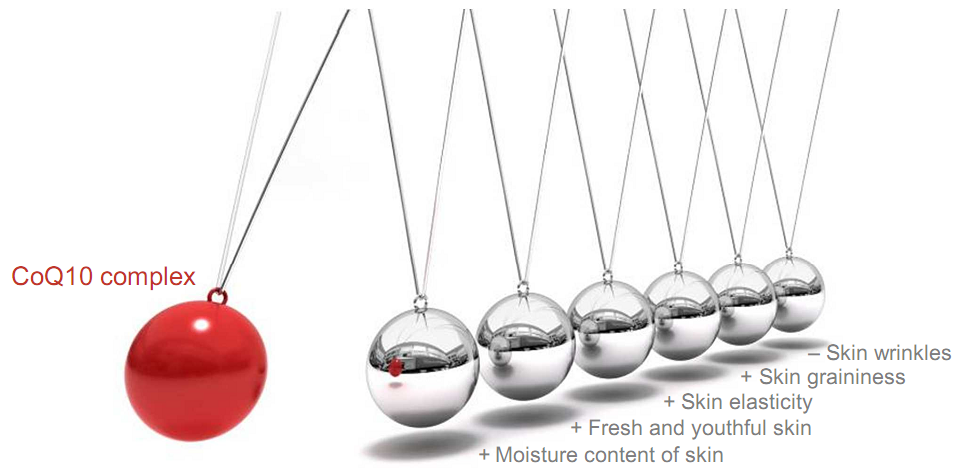
CoQ10’s serial effect on the skin

CoQ10 promotes secretion of collagen I from fibroblast
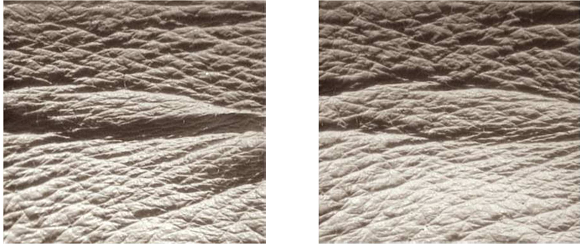
Before use, after use
CoQ10’s improvement on skin texture
NanoActive AA
Nano Active AA is a novel azelex nanoliposome preparation (NanoLiposomal AA).
Product Name: Nano Liposomal Azelaic; Nanoactive Azelaic acid; BioaActive Azelaic acid; Soluble Azelaic acid CAS: 123-99-9
Description:
Azelex, also known as azelaic acid, is a natural saturated dicarboxylic acid containing nine carbon atoms and is an important medium-long chain dibasic acid. Featured with the effect of inhibiting excessive secretion of grease, eliminating acne and skin whitening, as well as high security, Azelex has a long history of application in cosmetics. There is no restriction on its use in the 2007 edition of Cosmetic Hygiene Code. However, due to its low solubility, high melting point (105-106 °C), vulnerability to discoloration, poor compatibility, and strong irritation, its application is greatly limited. The NanoActive AA, developed with the nano-transmission system (NDS), has a particle size of less than 30nm, which solves the problems of solubility and irritation, so that it is stably encapsulated in nano-carriers, and can effectively penetrate into hair follicles and the deep layer of skin, thus greatly improving absorption efficiency and bioavailability (its derivatives need to be hydrolyzed to take effect) with higher efficiency and no irritation. It is a good solution to the deficiency of azelaic acid while maintaining the original advantages. It has good compatibility and is very effective in regulating the normal secretion of sebum, eliminating acne and skin whitening.
Rhododendron and azelaic acid
Azelaic acid is a characteristic raw material:


- It can be used for freckle and acne elimination as well as oil control
- It is also used in cosmetics and pharmaceuticals
- It is featured with both excellent functionality (as a raw material for freckle and acne elimination included in the authoritative dermatological pharmacopoeia) and also has good safety.
- Although it may not show an obvious whitening effect for ordinary skin, the effect on severe pigmentation such as freckles, chloasma and melanoderma is quite noticeable.
- There have been a large number of convincing data in clinical medicine
- Unlike common functional materials, it is very stable (no unsaturated double bonds in the molecular structure)
Active mechanism of azelaic acid:
- It competitively inhibits the action of tyrosinase and blocks melanin synthesis
- It inhibits the synthesis of microbial proteins and has a strong antibacterial effect on propionibacterium acnes, staphylococcus, proteus and escherichia coli.
- Azelaic acid competitively inhibits the action of 5-α reductase, thereby inhibiting the conversion of androgen to 5-androgen aldehyde
- It inhibits the secretion of free fatty acids in sebaceous glands and regulates the normal secretion of sebum
- It removes free radicals, controls inflammation, slows down the growth of keratinocytes
Product efficacy:
- Eliminating stains and whitening skin: It has a definite and significant effect on abnormal melanin (pigmentation caused by functional disorders), such as pigmentation (marks) and malignant melanoma caused by melasma, freckles, melanoderma, trauma (or hemorrhoids, etc.).
- Curing acne, eliminating skin acne, and regulating normal secretion of sebum
- Compatible with vitamin B6, and applicable to male hormone alopecia treatment by stimulating hair growth
Product Features :
- NanoActive AA uses FDA GRAS materials for high safety
- NanoActive SA is stable to heat, pH and shearing, so it is convenient to use.
- NanoActive AA overcomes the original shortcomings of azelaic acid while maintaining the advantages, and improves bioavailability
- NanoActive AA improves the stability of other actives in the product and facilitates absorption
Product use: it allows a wide range of applications, and can be used in various systems such as freshener, essence, cream, lotions, etc.Add it at room temperature. You may heat it to over 40℃ to speed up the dissolution. Recommended dosage: 1-5%.
Product storage: keep it away from light at a temperature below 25℃.
NanoActive ISO
NanoActive ISO is a novel soy isoflavone nanoliposome preparation (NanoLiposomal ISO).
Product Name: Nano Liposomal Soy Isoflaves; Nanoactive Soy Isoflavones; BioaActive Soy Isoflavones; Soluble Soy Isoflavones
CAS: 574-12-9
Description: Isoflavone is one of the flavonoids. It can be found mainly in legumes and is a secondary metabolite formed during the growth of soybeans. With a structure similar to estrogen, it is also called phytoestrogen, which can make up for the estrogen deficiency of women after 30 years old, increase skin moisture and elasticity, relieve menopausal syndrome and improve osteoporosis, thus enabling women to regain youthful charm. Soy isoflavone have been proved to be effective in anti-aging, and have a hormonal effect without side effects. However, due to the water-insolubility of soy isoflavone, it is difficult to be applied in cosmetics. NanoActive ISO is a new generation of nanoscale carrier containing soy isoflavone, which converts soy isoflavone into a completely water soluble form. By improving solubility, NanoActive ISO can easily penetrates into your skin and exerts the full effects of soy isoflavone.

Soy Isoflavone and Estradiol Structure
Soy isoflavone is featured with a similar activity to estrogen, and its main benefits to the skin include:
- Eliminating oxygen free radicals and resist aging:Promote the metabolism of skin cells and maintain skin elasticity. Prevent mature skin from degenerating due to lack of hormones
- Whitening:Inhibit tyrosinase as well as diminish chloasma and melasma
- Removing wrinkle:Promote collagen synthesis
- Skin Firming and Bust Beauty:Phytoestrogens supplement the body’s estrogen
- Inhibition to Androgen: Reduce the secretion of grease (acne skin), inhibit hair growth in arms and legs (depilatory), and promote scalp hair growth (thin hair)
NanoActive ISO encapsulates soy isoflavone in a nanoscale carrier composed of a polar lipid layer and a lipophilic core.

NanoActive is water-soluble even when it contains such an oil-soluble active as soy isoflavone. The solution is completely clear and transparent so NanoActive ISO is applicable to clear hydrogel formulations.
Formulation Advantages:
- Shearing stability
- pH stability
- Heat stability
- Improvement on skin texture
- Low viscosity
NanoActive technology improves the permeability of soy isoflavone by converting it to a water-soluble form, thereby enhancing the efficacy.

Cell Regulation of Collagen Formation and Degradation (estrogen-promoted synthesis)
The degradation signal is marked in red and the formation one in green.
E, estrogen; ER, estrogen receptor; EGFR, epidermal growth factor receptor;
TK, tyrosine kinase

Nano soy isoflavone increases skin thickness

Increase skin moisture

Improve skin firmness
Application
Anti-wrinkle and anti-aging cream, whitening, eliminating freckles and wrinkles, nourishing hair, facilitating hair growth, and depilatory cream
Formulation guidelines
Recommended dosage: 1% – 3%
Solubility: water and oil
pH: 2-6
Heat stability: stable
Electrolyte stability: no identified incompatibility
Shelf life: 1 year
Storage: Store with its original packaging at room temperature (<25 ° C).


